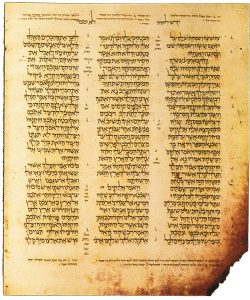Why critical editions of the Bible—like Biblia Hebraica Quinta—are essential


A MASTERPIECE OF THE MASORETES. The Masoretes established an astoundingly accurate tradition of Bible transmission. This carpet page from the Leningrad Codex (1008 C.E.)—of the tradition of the Masoretes—is the base text for Biblia Hebraica Quinta. The scribe of the manuscript Samuel son of Jacob, one of the Masoretes, even records his name. Photo by Bruce and Kenneth Zuckerman, West Semitic Research/With the Ancient Biblical Manuscript Center/Courtesy Russian National Library.
The Hebrew Bible—or Old Testament—that we have today differs from the Hebrew manuscripts of the Bible penned in the first millennium B.C.E. When transmitting any sort of a document from generation to generation, small alterations—some intentional, others not—are made. Even the most careful scribe makes errors, which are perpetuated and often compounded by future scribes. Thus, it should not surprise us that the Hebrew Bible, which has a transmission history of several millennia, contains textual difficulties, corruptions and even mistakes. Critical editions of the Bible examine these differences by looking at varying Hebrew witnesses and try to accurately reconstruct the original Hebrew manuscripts of the Bible. In the November/December 2013 issue of Biblical Archaeology Review, David Marcus and James A. Sanders discuss why critical editions of the Bible are necessary and describe the work that goes into creating such an edition in the article “What’s Critical About a Critical Edition of the Bible?”
Marcus and Sanders are both involved with the publication of Biblia Hebraica Quinta, the latest revision of Biblia Hebraica, which refers to the series of critical Bible editions published in Germany since 1905. The base for Biblia Hebraica Quinta is the Leningrad Codex, which dates to 1008 C.E. and was written by Samuel son of Jacob, who was part of a group of rabbinic scribes called the Masoretes.
The free eBook The Holy Bible: A Buyer’s Guide guides you through 33 different Bible versions and addresses their content, text, style and religious orientation. Updated Fall 2013 with brand-new reviews on six new Bible versions by Leonard J. Greenspoon.


THE MASORETES DOING WHAT THE MASORETES DO BEST. This page comes from the Aleppo Codex. Until a third of it was burned in a 1947 anti-Jewish uprising in Syria, the Aleppo Codex was considered to be the oldest, most complete, and most accurate of the Masoretes’ manuscripts. The Masoretes filled its margins with notes to safeguard against corruption. Credit: David Harris/Ben-Zvi Institute in the Shrine of the Book.
Working in Tiberias during the Middle Ages, the Masoretes recognized the possibility of human error when copying the Hebrew Bible. They tried to combat it by adding supplements to the text. In the margins of the Masoretes’ manuscripts, there are innumerable notes—masorah—to safeguard the text. The precision with which the Masoretes were able to preserve the Hebrew text beginning in the seventh century C.E. is astounding. Nevertheless, the Masoretes were not working with the original Hebrew manuscripts of the Bible. Corruptions had already crept into the versions they copied.
The Masoretes’ efforts preserved the Biblical text in the first millennium C.E. Modern scholarship, with critical editions of the Bible like Biblia Hebraica Quinta, is bringing us even closer to reconstructing the original Hebrew manuscripts of the Bible.
——————BAS Library Members: Read the full article “What’s Critical About a Critical Edition of the Bible?” by David Marcus and James A. Sanders as it appears in the November/December 2013 issue of Biblical Archaeology Review.
Not a BAS Library member yet? Sign up today.
Learn more about critical editions of the Bible and Hebrew manuscripts in the BAS Library:
James A. Sanders, “ReViews: The Art and Science of Textual Criticism,” BAR, May/June 2012.
Yosef Ofer, “The Shattered Crown: The Aleppo Codex Sixty Years After the Riots,” BAR, September/October 2008.
Marc Brettler, “The Masoretes at Work: A Tradition Preserved,” sidebar to James A. Sanders and Astrid Beck, “The Leningrad Codex: Rediscovering the Oldest Complete Hebrew Bible,” Bible Review, August 1997.
Learn about the Hebrew Bible in a free course of 25 video lectures by Harvard professor Shaye Cohen. Take the course >>
This Bible History Daily feature was originally published on October 25, 2013.
Get more biblical Archaeology: Become a Member
The world of the Bible is knowable. We can learn about the society where the ancient Israelites, and later Jesus and the Apostles, lived through the modern discoveries that provide us clues.
Biblical Archaeology Review is the guide on that fascinating journey. Here is your ticket to join us as we discover more and more about the biblical world and its people.
Each issue of Biblical Archaeology Review features lavishly illustrated and easy-to-understand articles such as:
• Fascinating finds from the Hebrew Bible and New Testament periods
• The latest scholarship by the world’s greatest archaeologists and distinguished scholars
• Stunning color photographs, informative maps, and diagrams
• BAR’s unique departments such as First Person and Strata
• Reviews of the latest books on biblical archaeology
The BAS Digital Library includes:
• 45+ years of Biblical Archaeology Review
• 20+ years of Bible Review online, providing critical interpretations of biblical texts
• 8 years of Archaeology Odyssey online, exploring the ancient roots of the Western world in a scholarly and entertaining way,
• The New Encyclopedia of Archaeological Excavations in the Holy Land
• Video lectures from world-renowned experts.
• Full online access to 50+ curated Special Collections,
• Four highly acclaimed books, published in conjunction with the Smithsonian Institution: Aspects of Monotheism, Feminist Approaches to the Bible, The Rise of Ancient Israel and The Search for Jesus.
The All-Access membership pass is the way to get to know the Bible through biblical archaeology.

